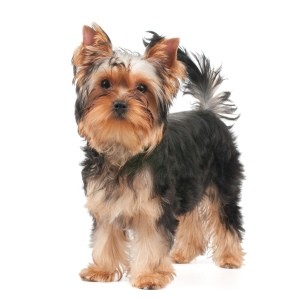 The Yorkshire Terrier, nicknamed Yorkie, is a small breed of dog first developed in 19th century England to catch mice and rats in textile mills. Today, this popular companion dog is known for its luxurious blue and tan coat, and its bold, inquisitive personality.
The Yorkshire Terrier, nicknamed Yorkie, is a small breed of dog first developed in 19th century England to catch mice and rats in textile mills. Today, this popular companion dog is known for its luxurious blue and tan coat, and its bold, inquisitive personality.
The Yorkshire Terrier was originally bred to help the working class, and therefore looked down upon by the wealthy. It didn't take long, however, for the beauty and personality of these little dogs to win over the hearts of the upper class. By the late 1800s there were dogs representing the breed in the United States, but they varied greatly in size and shape.
Yorkshire Terriers have busy, adventurous personalities. Because they were originally bred to think on their own, they are intelligent, independent thinkers, who possess a bit of a stubborn streak. Known for their over-protectiveness, they make good watch-dogs and will quickly sound the alarm whenever a stranger approaches. Though small in stature, Yorkies are not submissive lap dogs. Among strange dogs and other small animals they may become aggressive. These little dogs enjoy being doted on and make wonderful companions for seniors and families with older children.
Yorkies are known for having active, inquisitive personalities and require plenty of mental stimulation. Because Yorkshire Terriers were originally bred to assist humans they are intelligent and eager to learn by nature. Yorkies are not difficult to train, but like all terriers, they will quicklytake over the household without an owner who understands how to be a firm leader. As with many small dogs, this breed can be somewhat difficult to house train. A pack leader that provides plenty of mental stimulation and exercise through walks, training and games should have no problem cultivating a quiet, happy companion. The Yorkie is a good dog for apartment life. It is very active indoors and will do okay without a yard. It is not a cold hardy breed and prefers warmer climates.
The coats of Yorkies intended for show are extremely high maintenance. Traditionally, show coats are left long and the hair on the head is gathered in a topknot (band or ribbon) in order to give the dog maximum visibility. For the average owner, the level of care needed to maintain a show coat is much too time consuming. Most prefer to keep the fur trimmed short for easier care. Keep in mind though, even a clipped coat will need daily to weekly combing to keep it clean and mat-free. Compared to other breeds, the Yorkie sheds little to no hair.
As with any dog breed, Yorkshire Terriers are susceptible to certain health issues, including bronchitis, eye infections, and knee and spinal problems. The breed's small size makes them susceptible to fractures and other injuries and usually leaves them with a lower tolerance to anesthesia. Giving them foods outside their regular diet may upset their delicate digestive tract, resulting in bouts of vomiting and diarrhea.
Source: American Kennel Club; Wikipedia; The Yorkshire Terrier Club of America
I loved my Tuffy. I babysit him almost at least once a week for 11 wonderful years. Mostly even 2 or 3 days. His owner and his wife were dealing with health issues. From experience I can say he was stubborn with his house breaking. I have read this too.